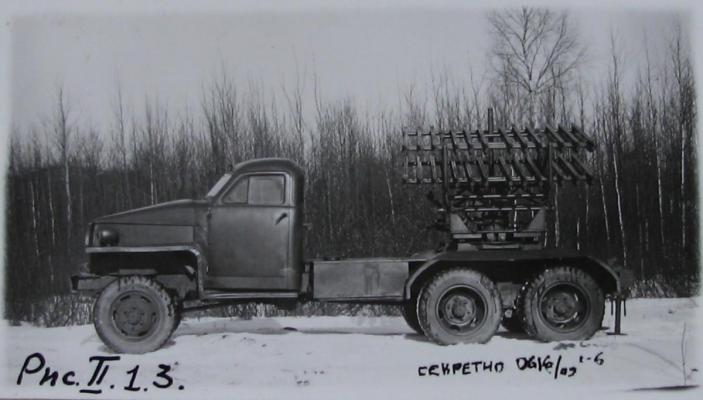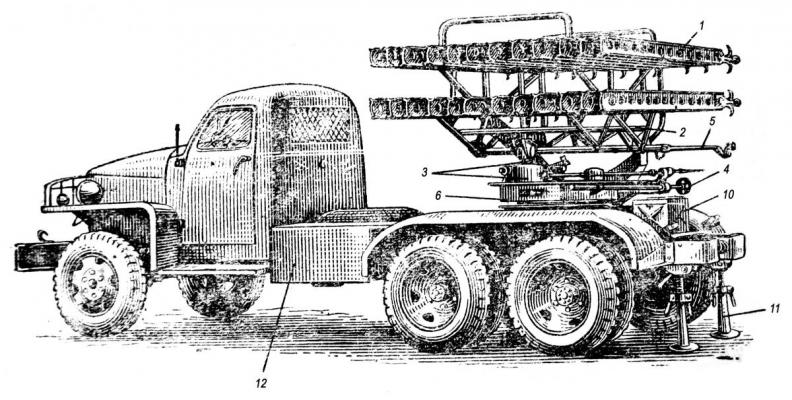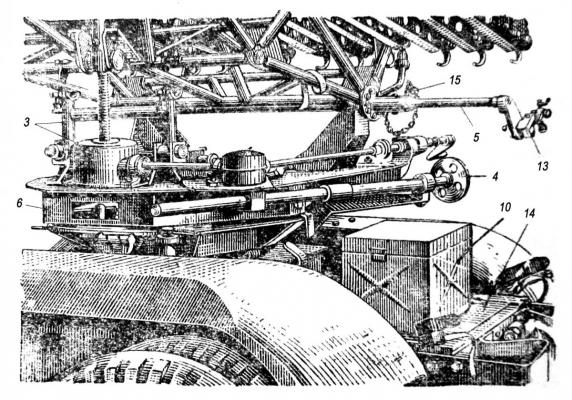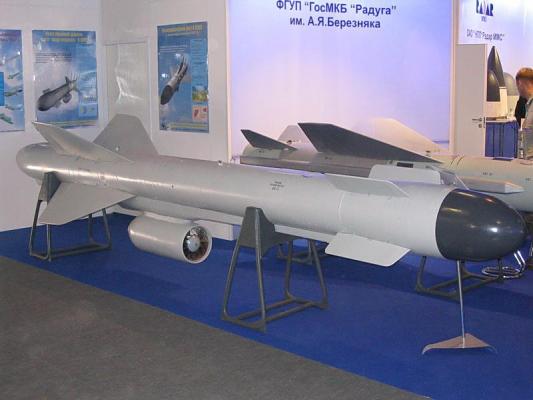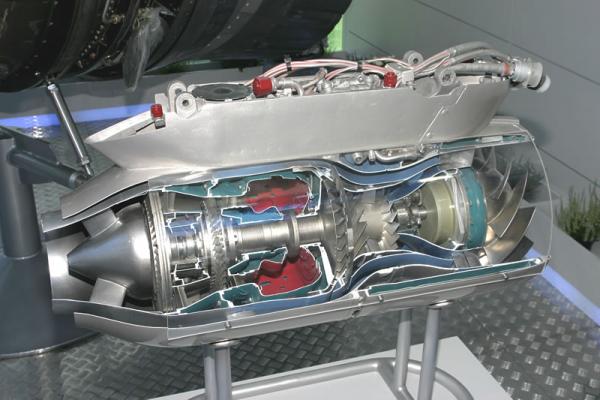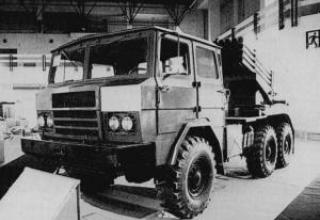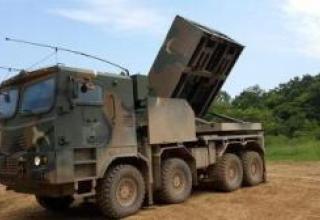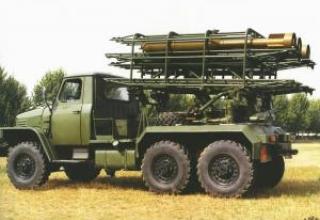The BM-8-48 fighting vehicle was designed for combat use in order to solve the following main tasks:
- the destruction of enemy manpower located openly and behind light field shelters;
- the suppression and destruction of enemy firepower.
The combat unit BM-8-48 on the chassis "Ford - Mormon" (see figure) was developed in April-June 1942, on the initiative of Chief Designer of SCB Barmin V.P.. The chassis was successfully tested and adopted for service by the Red Army. BM-8-48 became the main combat unit for launching M-8 rockets and was in service with the Guards mortar units until the end of the war.
In November 1943, on the initiative of the SKB, approved by the GUV HMH SC, the BM-8-48 48-loader was developed on the chassis of ZIS-6 vehicle. This unit was designed for the same purposes as the BM-8-36 on the chassis of "Ford Mormon" vehicle. All the main components of the design were unified with the units of serial combat vehicles: a package of rails with the BM-8-48 installation, and a swivel frame, lifting and swiveling pointing mechanisms and junction box - with the corresponding units of the BM-8-36 installation. The prototype of the BM-8-48 unit on the chassis of ZIS-6 was manufactured in December 1943, successfully passed the polygon tests and the unit was adopted for service by the Red Army. This variant is exhibited in the Military Historical Museum of Artillery, Engineering and Communication Troops (VIMAIVS, Russia, St.Petersburg). See the photos of this variant from VIMAIVS exposition: ( 1, 2, 3, 4, 5, 6, 7, 8, 9, 10, 11, 12, 13, 14, 15, 16, 17, 18 © S.V.Gurov Russia, Tula). During the war the production of the BM-8-48 combat vehicle was carried out by the Penza Plant No. 740 of the People's Commissariat for Mortar Weapons, the Milling Machines Plant (Gorky) and possibly others.
BM-8-48 combat vehicle had great maneuverability, which allowed for a short period of time to focus on an important direction of powerful firepower and suddenly open fire. Due to the sudden and massive fire of these combat vehicles inflicted a significant defeat and had a strong moral impact on the enemy.
Due to the high scattering of the rockets, only targets occupying a large area should have been fired from several combat vehicles at the same time in order to ensure sufficient firing density. Firing on small targets was ineffective.
A BM-8-48 combat vehicle could be fired in groups of three M-8 rounds, or in one volley, firing all 48 rounds within 8-10 seconds.
BM-8-48 was a movable special artillery machine, consisting of two main parts:
- of the artillery unit;
- the specially equipped chassis of the vehicle on which the artillery unit was mounted.
BM-8-48 was fundamentally different in its design from the artillery gun. It had no barrel and no chockback devices. Shots were fired from guide chutes; there were 48 such chutes for simultaneous charging with 48 shells.
BM-8-48 fighting vehicle in combat position (view on the left):
- 1 - guide package;
- 2 - a farm;
- 3 - lifting mechanism;
- 4 - swivel mechanism;
- 5 - sighting console with MP-41 sight;
- 6 - swivel frame;
- 10 - ZIP box;
- 11 - jacks; 12 - petrol tank protection
The main part of the BM-8-48 combat vehicle were packets 7, upper and lower; each of them consisted of twelve tracks - 24 tracks in total. Each guide at the top and bottom was equipped with a guide job, in which the projectile slid its centering nodes. At the base of each chute there was a longitudinal T-slot for the guide pins of the projectile. The guides were connected into packets by means of two transverse links, spars, and were installed in two tiers on tube farm 2.
Fighting vehicle BM-8-48 (side view):
- 3 - Lifting mechanism;
- 4 - swivel mechanism;
- 5 - sighting console;
- 6 - swivel frame;
- 10 - ZIP box;
- 13 - transition bracket;
- 14 - rear platform;
- 15 - conical pin
With the help of the lifting mechanism 3, the farm with the guide packs mounted on it could move in a vertical plane around the axis, located in the bushings of the rear brackets of the turning frame, thanks to which the guides were given the desired elevation angle between -3° and +45°. In a hiking position, the farm was mounted in a hinged bracket located at the front of the swing frame.
Horizontal guidance was provided by the pivoting mechanism 4, by means of which the pivoting frame 6 was rotated together with the guides around a vertical axis fixed in the center of the base. The base was fixed fixed fixed to the spars of the vehicle chassis.
Uncontrollable M-8 rockets were used for firing (see diagram). The rails were loaded from the breech block. M-8 projectiles were fixed in the required position by means of locks. The ignition of the projectiles was carried out by the pyro-pistols, which were fixed in the treasury part of the guides, in which the pyro-patroons, ignited by electric current, were inserted.
The source of electric current was two alkaline batteries of 5-NKN-45 type, installed in the battery box on the chassis foot. There was a switch for alternating connection of electric current to the pyroelectrons.
The switch was installed in the cabin of the vehicle. Closing the electric circuit and firing was possible only when the rails were placed across the vehicle chassis in the sector 50° on each side. For this purpose, a special contact device was installed in the junction box, in the middle part of the turning frame.
For pointing, the fighting vehicle had a sight, mounted in the head of console 5, hinged to the left flange of the farm axle. In hiking position the console was fixed to the farm using a belt with a buckle or in a bracket welded to the farm pipe in case of installation of the ZIS-3 sight.
Jacks 11 made it possible to horizontally position the combat vehicle on uneven terrain, without digging up the wheels, which shortened the time of preparation for combat. In addition, the jacks installed during firing reduced vibration of the vehicle.
The gas tank was covered with steel plates to prevent the gas jet and possible mechanical damage associated with the combat service of the vehicle. Spare parts, tools and accessories were stored in box 10 of the ZIP, located at the rear of the vehicle 14.
The entire artillery unit of the fighting vehicle was covered with a tarpaulin cover to protect it from dust, dirt and precipitation (see diagram).
With the exception of a set of pyro-pistol guides and a farm, the BM-8-SN prototype combat vehicle included units from BM-8-48 battle vehicle indexes 52-U-926 and 52-U-927, which were in service with the Red Army Guards mortar units.
The document dated 25.04.1946 on the study in the Main Artillery Directorate (GAU) of the remarks on the domestic armament received from the commanders of the groups of troops and districts and the data of the 4th Research Institute on the basis of the study of the war experience and the study of this armament at the GAU research firing ranges contains the following information on the alleged use of the reactive armament of the Guards mortar units in the postwar period:
- The first group - weapons that should remain in the ground troops, as the timekeeping: combat vehicles BM-8-48, BM-13 and BM-31-12 all on the chassis of the vehicle "Studebaker".
- SECOND GROUP - weapons to be withdrawn from the troops and stored in reserve - among others, the BM-8-48 fighting vehicle on the chassis of the "Chevrolet" was indicated.
- Third group - armament to be withdrawn from troops and sold as lost combat value: combat vehicles: BM-8-48, BM-8-32, BM-8-24 on the chassis of "ZIS-6", "GAZ-AA", "VILLIS" and tank "T-60";
Composition:
Like all Kh-59 family rockets, Kh-59MK rocket is made on the "tailless" scheme and is equipped with a cross-shaped triangular wing (see diagram). Four destabilizers are installed in the nose section of the hull. Compared with the X-59M missile has a new control system and a marching engine. Replacing the launch accelerator with an additional fuel tank has significantly increased the range of the missile (see diagram).
X-59MK is used to engage a wide range of surface radar-contrast targets with EPR more than 300 m2 (from a boat to a cruiser) at any time of day, both in simple and difficult weather conditions in the open sea and near the shoreline. The maximum range of the X-59MK missile for the destroyer-cruiser target is 285 km, for the boat target - 145 km (see the area of engagement). According to the developer's estimation, the probability of hitting the cruiser or destroyer is 0.9-0.96, and the probability of hitting the boat is 0.7-0.93. Thus, one missile is enough to hit the boat, and the estimated average number of hits to destroy the cruiser or destroyer is 1.8 and 1.3, respectively.
PKR X-59MK is equipped with an active radar homing head ARGS-59E, which in combination with modern noise-protected control system and a powerful BC provides high efficiency of combat application. The ARS-59E has been developed at the "Radar MMS" Research and Production Enterprise, OJSC. (St. Petersburg). The maximum range of detection of ARGS of "destroyer" type target (EEP>5000kv.m) -25km, "boat" type target (EEP>300kv.m) -15km. Angle of pumping ARGS antenna on azimuth - ±45 °, on a place corner - +10 ° ... -20 °. The missile is capable of performing complex flight trajectories with bypassing hazardous areas and all-around approach to the target (see diagram). The missile can be used in groups.
The X-59MK2 missile (see photo1, photo2) differs from the X-59MK by its correlation-optical homing head, which provides autonomous recognition of the area adjacent to the target. It is equipped with a navigation and automatic control system based on a free inertial navigation system and complemented by a satellite correction unit. The Kh-59MK (Kh-59MK2) missile control systems include the A-079E radio altimeter developed by the Detal Design Bureau. The low-altitude flight route to the target is specified in the flight task. Thus the missile's flight altitude above the ground surface (depending on the terrain relief) is only 50...300 m, which makes it extremely difficult to intercept air defense systems on the ground. The final homing system provides a circular probable deviation from a given point, which does not exceed 3 ... 5 m. The X-59MK2 missile can be used at any time of year, with illumination of 103 ÷ 105 lux above any type of terrain. Target angle at launch of X-59MK2 missile is up to ±45°.
The penetrating combat unit (PFC) weighing 320 kg (see photo) has a time delay fuse. The dimensions of the BMP are: diameter -380 mm, length -131 mm. The X-59MK2 missile can be equipped with a 283 kg cassette warhead (CBM) with shrapnel and cumulative effects.
Kh-59MK and Kh-59MK2 missiles are equipped with the highly economical low-resource 36MT turbojet engine. The 36MT engine (TRDD-50AT) was developed by the Omsk Engine Design Bureau (OJSC OMKB) and produced by NPO Saturn.
Turbojet engine 36MT of pylon version is double-circuit, twin-shaft, with coaxial shafts of low and high pressure cascades. Combustion chamber - ring semi-finished with rotating nozzle. High pressure cascade - axial compressor and single stage axial turbine, low pressure cascade - single stage fan with wide chord blades and single stage axial turbine.
The 36MT develops a static take-off thrust of 450 kgs at sea level with its own dry weight of 82 kgs, has a maximum cross-section size of 330 mm and length of 850 mm. Specific fuel consumption at maximum mode is 0.71 kg/kgf*h. The fuel used is T-1 (aviation kerosene), T-6, T-10 (decylin), TS-1, RT.
The engine operates in a fairly wide flight range with the ability to maneuver in height and speed (flight height from 0.2 to 11 km, flight speed up to 1100 km/h). To perform the flight program and regulation, 36MT is equipped with a modern electronic-hydraulic control system and a built-in 4 kW electric generator. The engine has an autonomous oil system.
Operating features of the 36MT engine:
- High fuel efficiency.
- Resistant to ingress of small foreign objects (birds, dust, etc.).
- Resistant to shock and heat waves.
- Ability to spontaneously escape from a pump after the cause of its disappearance.
- Reliable start in the whole range of external operating conditions (from +60° C to -50° C).
- High receptivity.
For the control of Kh-59MK missiles during their routine maintenance, an automated system for control of ASCs from the OSA complex is used, which was modified to control Kh-59MK missiles. SNO-106MA ground handling equipment is used to ensure the operation of missiles under conditions of technical position, transportation, storage in arsenals and warehouses, performing routine maintenance, inspection of missiles and their issuance for suspension under the carrier aircraft.
Set of delivery:
- combat version - X-59MK missile;
- Kh-59MK (UR) training and cutting version;
- Kh-59MK (UD) training and operational version;
- automated control system;
- ground handling equipment for Kh-59MK;
- Kh-59MK group missile instrumentation package;
- a set of operational documentation for the group missile.
Characteristics:
| Basic data of BM-8-48 combat vehicles | |||
| Vehicle brands of cars, which were modified for the installation of the artillery part of the chassis. | BM-8-48 standard index 52-U-926 | BM-8-48 standard index 52-U-927 | |
| Number of guide gutters, pcs. | 48 | ||
| Guide lengths, m | 2 | ||
| Largest elevation angle | 45° | ||
| Smallest elevation angle | -3° | ||
| Elevation angle in hiking position | - | 6° | |
| Angle of horizontal firing from each side of the vehicle in the sector | 50° | - | - |
| Horizontal aiming angle | - | 50° | |
| Minimum elevation angle when firing through the cabin | - | firing is not possible | |
| Lifting crank handle force, kg | 6-8 | 5 | |
| Turning handle force, kg | 6-8 | 5 | |
| Combat vehicle weight data on Studebaker chassis | |||
| Weight of one set of guideways, kg | 250 | - | - |
| Weight of complete guideway set as assembled, kg | 500 | ||
| Weight of the artillery unit, kg | 1835 | - | - |
| Weight of the entire artillery unit with a guide package without chassis, kg | - | 1800 | 1870 |
| Weight of the whole artillery unit with a guide package without a chassis and a set of shells, kg | 2200 | 2270 | |
| Weight of combat vehicle in hiking position, kg | 5485 | - | - |
| Weight of combat vehicle in combat position (loaded with 48 shells), kg | 5910 | - | - |
| Weight of combat vehicle assembled with full refueling, spare wheel and two Red Army men, kg | - | 5450 | 5520 (weighing was performed with an accuracy of 50-70 kg) |
| Weight of combat vehicle assembled with full refueling, spare wheel and two Red Army men in loaded condition, kg | - | 5870 | 5950 |
| Chassis weight Studebaker without bodywork with two full-drive axles, spare wheel and two Red Army, kg | - | 3636 | |
| Combat vehicle dimensional data on Studebaker chassis | |||
| Length in hiking position, mm | 6100 | ||
| Width in hiking position, mm | 2200 | ||
| Height in hiking position, mm | 2800 | 2700 | 2800 |
|
Position of the centre of gravity of the oscillating part relative to its axis of rotation in the charged state when camping: (a) In the direction of the length of the guideway b) perpendicular to the length |
- |
390 516 |
|
|
Position of the centre of gravity of the oscillating part in relation to its axis of rotation when it is not charged: (a) In the direction of the length of the guideways (b) perpendicular to length |
- |
687 486 |
|
| Operational data | |||
| Time of transition from camping to combat | 1.5 - 2 | - | - |
| The time it takes to charge a combat vehicle, min. | 5-6 | 10-15 | |
| Speed of fire | 48 shots in 8-10 seconds | - | - |
| Number of projectiles fired at one turn of the switch handwheel | 3-4 | ||
| Shrapnel projectile M-8 (ballistic index TC-34) | |
| General data | |
| Caliber, mm | 82 |
| Stabilizer wingspan, mm | 200 |
| The full length of the projectile, mm | around 714 |
| Weight of final projectile, kg | 7,98 |
| Weight of rigged head end, kg | 2,7 |
| Weight of bursting charge of the head, kg | 0,64 |
| Weight of the projectile part, kg | 5,13 |
| Weight of powder (rocket) charge, kg | 1,18 |
| Fuse brand | GWMZ and AM-A |
| Resistance of incandescent pyropatron bridge, Ohm. | 0,3-0,45 |
| The power of the current needed to ignite the pyrophatron, A. | 2,5-3 |
| Ballistics data | |
| Powder charge burning time, s | 0,5 |
| Average reactive force, kg | 450 |
| Muzzle velocity of the projectile, m/s | 50 |
| The length of the active section of the trajectory, m | 80 |
| Highest projectile speed, m/s. | 315 |
| The longest range of fire, m. | 5515 |
Testing:
The first launches of K-10 in marine aviation were made by North Sea crews on the Caspian Sea in July 1960. Having departed from the airfield of the 33rd Center near Nikolaev, a pair of Tu-16K-10s reached the target, and from a height of 10,000 m at a range of 175 km the crew of Colonel Myznikov made the launch. Due to a pointing error, the missile did not reach the target, having fallen into the sea at 40 km, the crew of Lieutenant Colonel Kovalev, who followed, attacked from a distance of 170 km, achieving a direct fall into the target - the tanker "Chkalov" drowned in shallow water. Within two weeks, three more attacks were carried out, one of which again failed due to operator's error, and in one missile hit the crest of the wave just 200 m from the ship.
The training and combat launches were accompanied by supervision of industry representatives - nevertheless, the system was accepted with many reservations and required prompt correction of defects. For this purpose, even a special design and technological bureau (SCTB) was organized with participation of engineers from MAP, Design Bureau, Research Institute and AUMF. The researches carried out on the basis of the 33rd Center showed the practical feasibility of target detection from 450 km by adjusting the frequencies and length of the radar pulses. It was possible to launch long-range missiles from 325 km, and the lower limit of the aircraft flight was 500-600 m. The radar antenna of the carrier carried out scanning, mechanically rotating through the azimuth of 120 °, making it possible to turn away from the target after launch and continue to provide escort. Usually, the turn-off was performed at the 100th second with a roll of 9-12°, dictated by the possibility of stabilization of the antenna. Approximation to the target, depending on the flight mode and altitude of the launch, did not exceed 140-160 km (later withdrawal from the attack at the start of K-10SD from the maximum range could be carried out at a distance of 265 km).
In one of the departures for tactical launch in 1961, the crew of Captain G.A.Zimin faced an emergency situation, when the missile released into the starting position could not be returned. Nothing good landed with a hanging missile did not promise, because with a normal landing angle of 8 °, there was a great risk of "combing" the missile on the ground. Nevertheless, the crew managed to get the plane to land successfully, and then the instructions for such a case were introduced in the pilot's instructions.
In 1960-62, the K-10 missile system was equipped with seven air regiments of all Soviet fleets: 2nd MRAD of the Black Sea, 5th MRAD of the North, 25th and 143rd MRAD of the Pacific and 57th MRAD of the Red Banner Baltic Fleet. The intensity of development and combat training of maritime aviation crews looked impressive: for the first six months of operation in 1960 there were 79 launches, the next - 126, and in 1962 - 147 (however, the reverse side was a large consumption of combat missiles, and a duplicate aircraft like "Kometa", which allows you to save money and expensive products, for the K-10 was not available).
Another shortcoming was revealed - poor preparedness of ground services for operation of complex equipment. At first, it was assigned to a special engineering and aviation service of SIS, and the issues of warehousing, engaged in repair and maintenance base. Getting rid of duplication of work, the structure was reorganized and introduced a division of responsibilities: all systems of the aircraft were serviced by IAS specialists regiment, and the full list of work on missiles was carried out by the maintenance base.
The measures taken allowed reducing the time of equipment preparation and improving the quality of work. The confirmation was the reduction of the number of unsuccessful launches due to mistakes in the preparation of the mattress - already in 1962, their number decreased by 20%. Near the aircraft were equipped with shelters, where there were refueled and equipped with missiles, pre-tested and flying in the air on "its" carrier. The procedure of suspension and preparation of K-10 was reduced to 45 minutes, and this work was fully carried out by regimental technicians and crews - preparation for the departure of two squadrons with 16 Tu-16K-10 reduced in time by half.
We managed to reduce the number of failures, although the number of complaints about the shortcomings and defects of the system remained tangible, so the reliability of the Tu-16K-10 was inferior to other, simpler complexes, primarily through the fault of the equipment. In 1961, almost half of the completed launches failed, and about a third - due to design and manufacturing flaws.
Face-to-face with Soviet missile carriers, the United NATO Fleet had to meet in September 1964 during a major exercise "Tim Work-64", covering the entire North Atlantic. More than half a dozen ships, including two aircraft carrier groups, participated. The squadron was discovered by Tu-95 reconnaissance aircraft of the Northern Fleet, after which the command of the 5th MRAD offered to organize a response exercise with the use of aviation "on real targets", showing, for example, the head of the country to the Americans "Kuzkinu mother". Command of the Navy, however, was afraid of bringing the situation to the brink of unleashing a real war, but the top leadership of the country gave the conceived "good".
By order of the Air Force Headquarters of the NF plan was adopted for implementation. In the evening of September 21, three squadrons of Tu-16K-10 strike team of Lieutenant Colonel KL Timakov, as well as scouts, designators and interference operators who were covering the missile carriers. The ship's group was found in the ocean, the planes at low altitude stealthily reached the border of the attack. The "missile strike" was launched from three directions with a distance of 160-200 km, and the enemy was helpless to repel it.
At TOF in 1964 there was a case of attack K-10S Japanese ship, which was in the restricted zone of the range. Shino-Maru" was held near Cape Tyk, where the crew of Tu-16K-10 from the 169th MRAP worked out a training task. Having refocused, the rocket went exactly on a new "target". The Japanese were lucky - the fuse was set to detonate on the trajectory to save the targets, and the explosion occurred 400 meters from the board. The wreckage damaged the superstructure and the rocket's engine broke through the ship. Among the crew were wounded, which forced the Japanese to go to the nearest Soviet port of Kholmsk for medical care and repair. The incident managed to jam, and the Japanese side believed that the ship was hit by a crashed Soviet fighter, and expressed sympathy for the lost pilot.
During the largest strategic exercise "Ocean", held in April 1970 and covering all the fleets and water areas, the North Sea Tu-16K carried out 6 rocket launches at the range, thrown into reinforcements to them 10 missile carriers with TOF April 20 attacked the target missiles near the Kola Peninsula. Nine Tu-16K-10 of the Pacific 143rd MRAD, supported by five tankers, carried out tactical attacks in the Sea of Japan, using groups of NATO and U.S. ships as targets.
The Baltfleet's Tu-16K-10 was airborne when it intercepted the mutinous SCR "Storozheva," which left the base and headed for the Strait of Irben during the October 1975 holidays. It was supposed that he wanted to go abroad, and to stop this attempt on November 8 and 9 all forces of the fleet and aviation were alerted. Rocket attack in the area with busy shipping, fortunately, did not take place - Tu-16 found the target when the ship has already been bombed and stalled cars, but they accompanied him on the way back to the base.
With the organization of the base of the Soviet fleet in the Vietnamese port of Kamran there was placed 169th gv. SAP, which, in addition to scouts, target designation and anti-submarine aircraft, at the front positions was a squadron of Tu-16K-10-26. They served there from 1982 to 1989.
Sources:
- Армейский сборник. Выпуск №1, январь 1999 года., - С.56.
- Боевая машина БМ-8-48. Руководство службы. Военное издательство Министерства вооруженных сил Союза ССР, Москва, 1947 г. - С.3-7,105,110. (Смотрите электронный вариант издания).
- Краткая история СКБ-ГСКБ Спецмаш - КБОМ" под редакцией В.П. Бармина, 1 книга: "Создание ракетного оружия тактического назначения 1941-1956 гг.", Москва, 1967 г. - С.28-30,48.
- ЦАМО РФ. Ф.81. Оп.173178сс. Д.429. ЛЛ.35-37.
- ЦАМО РФ. Ф.81. Оп.160820с. Д.4. Л.32.
- ЦАМО РФ. Ф.81. Оп.170760сс. Д.2503. Л.5.
- ЦАМО РФ. Ф.81. Оп.119120сс. Д.37. ЛЛ.116,120,121.
- ЦАМО РФ. Ф.81. Оп.119120сс. Д.38. ЛЛ.113,115-116,120,122.
- ЦАМО РФ. Ф.81. Оп.160827сс. Д.11. Л.5.
